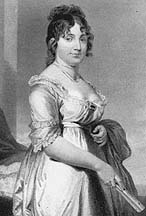WOMEN IN HISTORY - DOLLEY MADISON
First Lady and doyen of Washington society
DATE OF BIRTH
Born Dolley Payne - May 20, 1768
|
PLACE OF BIRTH
New Garden settlement (now Guilford County), North Carolina.
|
DATE OF DEATH
July 12, 1849
|
PLACE OF DEATH
Washington, D.C.
|
FAMILY BACKGROUND
Born to Quaker parents, her family moved from North Carolina to a plantation in Scotchtown, Hanover County, Virginia when she was an infant. At age 15, she again relocated with her family to Philadelphia.
ACCOMPLISHMENTS
Of the early First Ladies in the United States, Dolley Madison, wife of James Madison, fourth President of the United States, has been considered the most colorful. In her eight years in Washington, D.C. (1809-1817), she made the White House a most delightful place to visit. Beautiful gregarious, buoyant, and cheerful, the regular social gatherings she hosted were lively events at which anyone would feel welcome. Through her special inviting manner the often tense political, as well as social, atmosphere of Washington could become wonderfully calm. Despite her strict Quaker upbringing, Dolley Payne possessed a sparkling personality and a kind heart. On Jan. 7, 1790, she married John Todd, Jr., a Philadelphia lawyer and fellow Quaker. They had two sons John Payne and William Temple. In 1793 a yellow fever epidemic hit Philadelphia, claiming the lives of her husband and son William within weeks of each other. Dolley's characteristic optimism enabled her to get through this tragedy and continue to live life to its fullest. She attended various social functions in Philadelphia, then the capital of the United States. At one of which, through Senator Aaron Burr of New York, Dolley was introduced to Representative James Madison of Virginia, renowned as the architect of the United States Constitution. Though 17 years her senior, Dolley and James soon began a courtship, culminating in his proposal of marriage and her acceptance. On Sept. 15, 1794, James Madison, age 43, and Dolley Payne Todd, 26, were married. Because James Madison was an Episcopalian, Dolley was ostracized from the Society of Friends (Quakers) for marrying outside her faith.
Freed of the quaintness of Quaker doctrine, Dolley's liveliness began to manifest itself in her appearance as well as her personality. She began taking snuff, and wearing bright clothing and turbans adorned with jewelry or feathers. In particular Dolley discovered she enjoyed giving large formal dinner parties and entertaining her guests at Montpelier, the Madison family estate in Orange County, Virginia. Her receptions soon attracted attention throughout the state, and this proved favorable to her husband's political career. In 1801, the newly inaugurated President Thomas Jefferson appointed James, a friend and fellow Democratic-Republican, as Secretary of State.
Dolley took to Washington, D.C., society like a duck takes to water, and she was given a golden opportunity when Thomas Jefferson, a widower, asked her to serve as his hostess at White House social functions. Her extroversion served to enliven the often austere atmosphere of the Jefferson administration, in addition to providing the harmony needed to quell the political tensions. The first eight years Dolley was in Washington, her influence fomented the role she would assume after James was elected president in 1808.
Once Dolley Madison became first lady in 1809, her status as the central figure of Washington society was confirmed. The vivacious Dolley's expansive memory for names and ability to make everyone at home in the White House attracted guests by the many. Her lavish dinner parties were noted for the surprise delicacies served. She began holding Wednesday evening "drawing rooms" (receptions) that became immensely popular with politicians, diplomats, and the citizenry. Not only was Dolley renowned for her charm, but her knowledge of politics and current events was significant as well. She proved an asset to James's political career in two ways: her outgoing demeanor complemented his reserved and stonefaced disposition and her political insight influenced his decision-making. Undoubtedly, Dolley was one of the reasons James won reelection in 1812.
During the War of 1812, Dolley's role as first lady was tested when British troops invaded Washington in August 1814. Courageously, she stayed behind until vital state documents and, most notably, the famous portrait of George Washington by Gilbert Stuart were removed to safety. Fleeing Washington with James, they returned three days later to find the White House burned down. While the reconstruction process was underway, James and Dolley resided at the Octagon House for the remainder of his presidency. Nonetheless, Dolley made the most of the situation and the gaiety of Washington society, through her entertaining, returned as potent as always.
With the conclusion of his second term in 1817, James and Dolley retired to Montpelier. Life on the plantation proved vibrant as Dolley continued to entertain guests as before. However, the prodigality of her son John, with whom both she and James were always too lenient, brought them financial problems. On June 28, 1836, James Madison died at the age of 85. Though childless, their 42-year marriage had been a remarkably blissful and happy one. Unfortunately, John Payne Todd's spending habits soon reduced his mother almost to poverty. This forced Dolley to sell both James's Continental Papers and Montpelier to pay the creditors. In 1837, Dolley returned to Washington and resumed her former status in the social life there. Dolley frequented numerous social and political events and was beloved by all. On July 12, 1849, Dolley Madison died in Washington at age 81. She was buried in the Congressional Cemetery with all the Washington dignitaries attending. Later her remains were moved to Montpelier next to her husband's.
Freed of the quaintness of Quaker doctrine, Dolley's liveliness began to manifest itself in her appearance as well as her personality. She began taking snuff, and wearing bright clothing and turbans adorned with jewelry or feathers. In particular Dolley discovered she enjoyed giving large formal dinner parties and entertaining her guests at Montpelier, the Madison family estate in Orange County, Virginia. Her receptions soon attracted attention throughout the state, and this proved favorable to her husband's political career. In 1801, the newly inaugurated President Thomas Jefferson appointed James, a friend and fellow Democratic-Republican, as Secretary of State.
Dolley took to Washington, D.C., society like a duck takes to water, and she was given a golden opportunity when Thomas Jefferson, a widower, asked her to serve as his hostess at White House social functions. Her extroversion served to enliven the often austere atmosphere of the Jefferson administration, in addition to providing the harmony needed to quell the political tensions. The first eight years Dolley was in Washington, her influence fomented the role she would assume after James was elected president in 1808.
Once Dolley Madison became first lady in 1809, her status as the central figure of Washington society was confirmed. The vivacious Dolley's expansive memory for names and ability to make everyone at home in the White House attracted guests by the many. Her lavish dinner parties were noted for the surprise delicacies served. She began holding Wednesday evening "drawing rooms" (receptions) that became immensely popular with politicians, diplomats, and the citizenry. Not only was Dolley renowned for her charm, but her knowledge of politics and current events was significant as well. She proved an asset to James's political career in two ways: her outgoing demeanor complemented his reserved and stonefaced disposition and her political insight influenced his decision-making. Undoubtedly, Dolley was one of the reasons James won reelection in 1812.
During the War of 1812, Dolley's role as first lady was tested when British troops invaded Washington in August 1814. Courageously, she stayed behind until vital state documents and, most notably, the famous portrait of George Washington by Gilbert Stuart were removed to safety. Fleeing Washington with James, they returned three days later to find the White House burned down. While the reconstruction process was underway, James and Dolley resided at the Octagon House for the remainder of his presidency. Nonetheless, Dolley made the most of the situation and the gaiety of Washington society, through her entertaining, returned as potent as always.
With the conclusion of his second term in 1817, James and Dolley retired to Montpelier. Life on the plantation proved vibrant as Dolley continued to entertain guests as before. However, the prodigality of her son John, with whom both she and James were always too lenient, brought them financial problems. On June 28, 1836, James Madison died at the age of 85. Though childless, their 42-year marriage had been a remarkably blissful and happy one. Unfortunately, John Payne Todd's spending habits soon reduced his mother almost to poverty. This forced Dolley to sell both James's Continental Papers and Montpelier to pay the creditors. In 1837, Dolley returned to Washington and resumed her former status in the social life there. Dolley frequented numerous social and political events and was beloved by all. On July 12, 1849, Dolley Madison died in Washington at age 81. She was buried in the Congressional Cemetery with all the Washington dignitaries attending. Later her remains were moved to Montpelier next to her husband's.
WEBSITES
CITATION
This page may be cited as:
Women in History. Dolley Madison biography. Last Updated: 2/23/2013. Women In History Ohio.
<http://www.womeninhistoryohio.com/dolley-madison.html>
Women in History. Dolley Madison biography. Last Updated: 2/23/2013. Women In History Ohio.
<http://www.womeninhistoryohio.com/dolley-madison.html>

